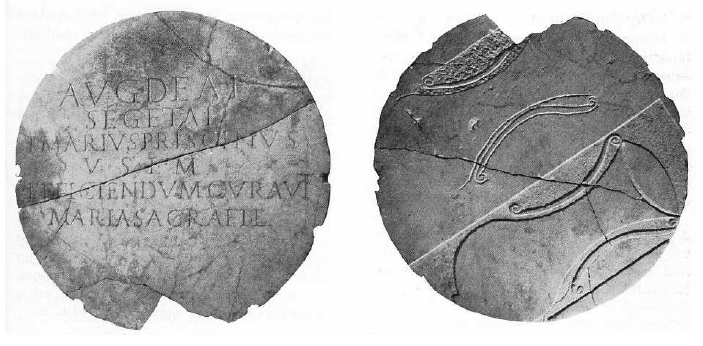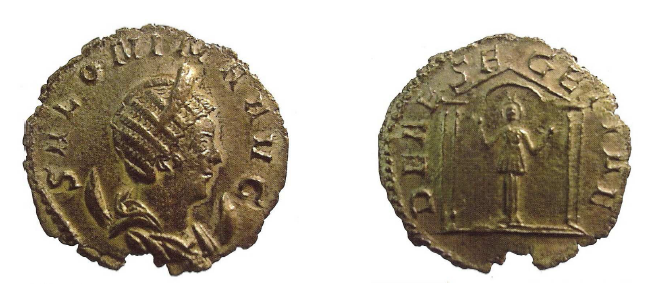3) Goddesses of Victory
a) Segeta (‘Victory’)
The goddess Segeta is mentioned in three inscriptions, in Bussy-Albieu (Loire) with Dunisia (see above), in Feurs (Loire) and in Sceaux-en-Gâtinais (Loiret), where healing water sanctuaries were excavated. Segeta’s name is based on a Celtic root sego- meaning ‘victory’, ‘strength’, derived from an Indo-European root *seĝh- meaning ‘to subject’, ‘to conquer’, ‘to vanquish’.1588 This root is found in many proper names, such as Segolatius(‘Hero-of-the-Victory’) and Segorix (‘Victorious King’), and many placenames, for instance Sego-briga (‘Fortress-of-Victory’), the present-day city Segorbe, situated to the north of Valencia in Spain. From the ending of her name in –ta, found for instance in Rosmerta, it can be deduced that Segeta is a name of action.1589 Her name is thus related to war and can be glossed as ‘the Victorious One’, that is the one who ensures victory over the foes. As far as Olmsted is concerned, her name should be linked to the Irish ségda, ‘lucky, fortunate, propitious’, on account of her close association with curative waters.1590 According to him, Segeta would be ‘the Fortune Bringer’ or ‘the Propitious One’, but this etymology* is highly unlikely.
Segeta is etymologically related to the goddess Segomanna, venerated on the plateau of ‘Bois de Labaume’ (Gard), and possibly to the Matronis Seccanehis (*sekkon-ikā-), honoured in Euskirchen (Germania Inferior), whose name might be based on the root secco-, a derivation from Celtic sego: Matronis Seccannehis Secundinus Certus [v]slm, ‘To the Matronae Seccannehae Secundinus Certus paid his vow willingly and deservedly’.1591 The dedicator bears the duo nomina of Roman citizens.
Segeta may originally have been the tutelary goddess of the Segusiavi (‘The Victorious Ones’), who had Forum Segusiavorum (Feurs) for their chief city in Gallo-Roman times.1592 A dedication, engraved on a bronze weight of ten Roman pounds (=3.81 kilograms), probably dating from the 2nd or 3rd c. AD, was indeed discovered in 1525 in Feurs. The weight must have been left as a standard in honour of the goddess. The inscription is the following: Deae Seg(etae) F(ori) ou F(orensium?) p(ondo) X, ‘To the goddess Segeta of Feurs (this weight) weights ten (Roman livres)’ (X=decem=ten).1593 Archaeological excavations carried out in 1979-1980 in Feurs revealed the remains of a Gaulish village, dating from the 3rd or 2nd c. BC, which developed into a city, where thermal baths and a water sanctuary may have been erected in Gallo-Roman times.1594
Another inscription was unearthed in the territory of the Senones, in Sceaux-en-Gâtinais (Loiret), called Aquae Segetae in Gallo-Roman times according to the 4th-century AD Table de Peutinger.1595 The inscription is engraved on a fragmented disc in pinkish marble (diam. 64 cm), on the reverse of which two long vases, fish and curves or waves redolent of the undulations of water are drawn. Those drawings are either linked to Segeta and reminiscent of her watery aspect or they are of later date and were added when the disc was re-used*. The dedication reads: Aug(ustae) deae Segetae T(itus) Marius Priscinus v(otum) s(olvit) l(ibens) m(erito) efficiendum curau(i)t Maria Sacra fil(ia), ‘To the August goddess Segeta, Titus Marius Priscinus paid his vow willingly and deservedly, Maria Sacra, his daughter, took care to realise it’ (fig. 35).1596 The dedicator bears the tria nomina of Roman citizens, and his daughter has Latin names.

Aquae Segetae (‘The Waters of Segeta’) was apparently an important religious water sanctuary, located in the locality of Le Préau, La Rivière, situated to the north of the Chemin de César, 2.3 kilometres from Sceaux-en-Gâtinais.1597 The inscription was discovered in 1973, together with statues of mother goddesses and Venus Anadyomenes*, at the site of a monumental set of Gallo-Roman buildings, dated 1st c. AD, composed of a fanum* and several water sanctuaries, which included a number of rooms, baths, piping, yards and esplanades, organised around a healing spring. Moreover, anatomic ex-votos* in bronze and silver, representing feet, legs, masculine genital organs and prophylactic eyes were discovered on the site. This undoubtedly indicates that pilgrims came to the sanctuary to pray to the healing water-goddess and to have their pains soothed.1598 Excavations revealed that a vast paved yard surrounded by a portico protecting a series of small rooms (cellae*) was erected around basin n°XI, where the inscription was found. Those rooms were interpreted as small shops or incubation* rooms, where the sick pilgrims could have slept and waited overnight for divine intervention.1599 The name of the water sanctuary and the dedication enable us to assert that Segeta was the healing goddess presiding over the waters of this site.
It is interesting to note that Segeta is similar to a minor Roman deity (indigitamenta), called Segesta, who presided over harvest time and watched over grown corn. As Pliny relates in his Natural History, Segesta had her image in the sanctuary of Consus, at the bottom of the Palatine Hill, in the valley of the Circus.1600 He explains that her name is linked to the word segetes, ‘crops of standing corn’:
‘numa instituit deos fruge colere et mola salsa supplicare atque, ut auctor est hemina, far torrere, quoniam tostum cibo salubrius esset, id uno modo consectus, statuendo non esse purum ad rem divinam nisi tostum. is et fornacalia instituit farris torrendi ferias et aeque religiosas terminis agrorum. hos enim deos tum maxime noverant, seiamque a serendo, segestam a segetibus appellabant, quarum simulacra in circo videmus.Numa first established the custom of offering corn to the gods, and of propitiating them with the salted cake; he was the first, too, as we learn from Hemina, to parch spelt, from the fact that, when in this state, it is more wholesome as an aliment. This method, however, he could only establish one way: by making an enactment, to the effect that spelt is not in a pure state for offering, except when parched. He it was, too, who instituted the Fornacalia, festivals appropriated for the parching of corn, and others, observed with equal solemnity, for the erection and preservation of the "termini", or boundaries of the fields: for these termini, in those days, they particularly regarded as gods; while to other divinities they gave the names of Seia, from ‘sero’, ‘to sow’, and of Segesta, from tile ‘segetes’, or ‘crops of standing corn’, the statues of which goddesses we still see erected in the Circus.1601 ’
Similarly, Saint Augustine, the bishop of Hippo Regius (present-day Annaba, Algeria), who was a famous Christian theologian and historian at the end of the 4th c. and beginning of the 5th c. AD when the Roman Empire was collapsing, explains in his De Civitate Dei or City of God (413-426 AD) - which investigates the ancient pagan religions of Rome - that the crops were presided over by different goddesses. Segetia was the one who attended to wheat and corn when they were already grown. Saint Augustine adds that her name is related to Latin seges, ‘crop’:
‘Nec agrorum munus uni alicui deo committendum arbitrati sunt, sed rura deae Rusinae, iuga montium deo Iugatino; collibus deae Collatinam, uallibus Valloniam praefecerunt. Nec saltem potuerunt unam Segetiam talem inuenire, cui semel segetes commendarent, sed sata frumenta, quamdiu sub terra essent, praepositam uoluerunt habere deam Seiam; cum uero iam essent super terram et segetem facerent, deam Segetiam; frumentis uero collectis atque reconditis, ut tuto seruarentur, deam Tutilinam praeposuerunt. cui non sufficere uideretur illa Segetia, quamdiu seges ab initiis herbidis usque ad aristas aridas perueniret?They decided that responsibility for the land should not be entrusted to any one god; they put the goddess Rusina in charge of the rural countryisde; they consigned the mountain ranges (iuga) to the care of the god Jugatinus ; the hills (colles) to the goddess Collatina , the valleys to Vallonia. They could not even find the goddess Segetia adequate on her own, to the responsibility for the crops (segetes) from start to finish. Instead, they decided that the corn when sown (sata) should have the goddess Seia to watch over it as long as the seeds were under ground ; as soon as the shoots came above the ground and began to form the grain (seges), they were under the charge of the goddess Segetia ; but when the corn had been reaped and stored the goddess Tutilina was set over them to keep them safe (tuto). Would not anyone think that Segetia should have been competent to supervise the whole process from the first green shoots to the dry ears of corn?1602 ’
Interestingly, in the 3rd c. AD, coins stamped with the effigy of Salonina, the wife of the Emperor P. Lucinius Egnatius Gallienus (253-268 AD), had the following legend on the reverse: Deae Segetiae (fig. 36). The goddess wears a very short dress and is represented in a tetra-style temple, i.e. a temple with four front columns. She raises her arms towards the sky and a sort of halo or crown surrounds her head. It is possible that the Emperor’s wife, in periods of calamity, had recourse to the harvest goddess Segetia to implore her benevolence and fertility.

From a linguistic point of view, it would appear that Segeta (‘the Victorious’) was a martial protective goddess, invoked in time of war to ensure victory to her people. The archaeological discoveries in Feurs and Sceaux-en-Gâtinais indicate that Segeta was a healing goddess presiding over curative waters, worshipped by sick pilgrims to be relieved from their pains and sufferance. Finally, comparative mythology allows us to assume that Segeta was similar to Roman Segesta/Segetia and was originally a land-goddess, watching over crops and bringing prosperity to her people. From this, it follows that Segeta is a multi-sided goddess who had various land, healing, protective and war functions, which varied according to the time, place and needs of the population.